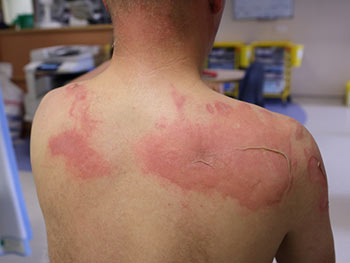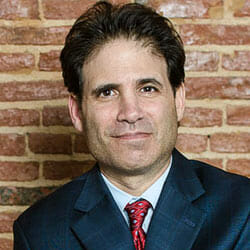 Burn injuries – whether they were caused by a flame, chemical spill or electrical contact – can be devastating for the victim and his or her family. Steve Heisler, The Injury Lawyer, has been helping the hardworking people of Maryland since 1988. Before Steve became a lawyer, he was an organizer and business agent for the Hotel Employees and Restaurant Employees Union, Local #7, in Baltimore. He knows how hard it can be for a family if the breadwinner suffers an occupational injury due to an employer’s negligence. And in his more than 25 years of practicing law, he has seen the devastating injuries that were caused by fires, explosions and dangerous chemicals in settings other than a job site, and he has worked hard to see that these victims received fair and complete compensation. If you or your loved one was burned because another person or company was negligent or manufactured a dangerous product, call Steve at (410) 625-4878 for a free consultation. Below are answers to some of the most commonly asked questions about burn injuries.
Burn injuries – whether they were caused by a flame, chemical spill or electrical contact – can be devastating for the victim and his or her family. Steve Heisler, The Injury Lawyer, has been helping the hardworking people of Maryland since 1988. Before Steve became a lawyer, he was an organizer and business agent for the Hotel Employees and Restaurant Employees Union, Local #7, in Baltimore. He knows how hard it can be for a family if the breadwinner suffers an occupational injury due to an employer’s negligence. And in his more than 25 years of practicing law, he has seen the devastating injuries that were caused by fires, explosions and dangerous chemicals in settings other than a job site, and he has worked hard to see that these victims received fair and complete compensation. If you or your loved one was burned because another person or company was negligent or manufactured a dangerous product, call Steve at (410) 625-4878 for a free consultation. Below are answers to some of the most commonly asked questions about burn injuries.
I thought a burn happens when a person comes in contact with a fire. Are there other types of burns?
Yes. In addition to contact with fire or flame, people can be burned by scalding, electricity, chemicals, contact with a hot item, explosions and radiation.
How do scalding burns happen?
You may think of scalding as something that happens when a person spills a pot of hot water on themselves, but, of course, it is also possible that a person could be scalded because of someone else’s actions or because a restaurant kitchen has dangerous procedures or inadequate safety measures. Scalding injuries also occur when showers and bathtubs are not supplied with temperature regulators. When tap water reaches 140° F, it can cause a third degree burn in just five seconds. Apartment complexes, nursing homes, hotels and motels, hospitals, and dormitories may endanger bathers by failing to install safety mechanisms on hot water tanks and plumbing devices. Nursing homes and assisted living residents who are not adequately supervised while bathing may sustain scalding burns.
How does electricity cause a burn?
Electricity is one of the most potentially dangerous commodities of our civilized society. While some electrical burns result from being struck by lightning, the vast majority are caused by contact with a manmade electrical current. A common cause of low-voltage electric burns is contact with an extension cord where the insulating material has worn off from wear or misuse. High-voltage electric burns may come from an electric arc or an electric current. In the case of an arc, the electricity travels through the air, releasing tremendous amounts of energy/heat. Temperatures as high as 36,000° F have been recorded in arc flashes, and they can melt a person’s clothing and completely destroy skin and tissue, requiring skin grafts or amputations.
What are some of the causes of chemical burns?
Chemical burns can happen without warning. There is no smoke or sound alert. Chemical burns can be caused by direct contact with one dangerous material, or by contact with a substance that reacts when combined with another substance, or by breathing chemicals in a gaseous form. Some of the chemicals that can be harmful are acids, like industrial cleaners and rust removers. Others are bases or alkaline in nature, like lime, potassium or sodium hydroxide, and ammonia. Solvents, degreasing agents, and gasoline are hydrocarbons, also dangerous. Most cases of toxic chemical exposure occur in factories or locations where dangerous chemicals are manufactured or stored, but even office workers can suffer chemical burns from exposure to fumes if their work areas are insufficiently ventilated, and homeowners can be harmed by chemical spills in a nearby plant or a railroad or highway accident.
Can explosions lead to burn injuries?
Many fires are caused by explosions. They can occur when static electricity sparks solid materials or gases into flames. A single spark from a cigarette or the operation of machinery can ignite fuel and cause it to explode. Natural gas or propane can explode into raging fires. Even dust can ignite and explode with enough force to destroy a building. Dust may be created in factories where grinding and polishing are done. Graineries and plants producing and storing agricultural products are prime candidates for dust explosions and fires. While the explosion may take place as a result of commercial activity, innocent bystanders and area residents are often among the victims.
What is the most common type of burn, generally?
Burn centers report the following statistics about the cause of admissions: 43% fire/flame, 34% scald, 9% contact, 4% electrical, 3% chemical, 7% other.
What is the incidence of burn injuries in the U.S.?
Experts estimate that 450,000 people receive treatment for burn injuries in the U.S. each year. That includes both those who are treated in emergency rooms or clinics and released and those who have to be admitted to a hospital or burn center for more extensive treatment.
How many deaths are due to some sort of burn?
According to the American Burn Association, about 3,500 lives are lost each year in fires or from burns.
Where do burn injuries usually happen?
Most burn accidents take place in the home and in the workplace.
If people are burned in a house fire, how can a lawyer help?
A Baltimore burn injury attorney will utilize the expertise of fire investigators to uncover the cause of the fire and identify any party which had a part in creating the dangerous situation – and there could be several. Residential fires can result from:
- faulty wiring
- malfunctioning smoke detectors
- defective appliances, such as space heaters
- a contractor who took shortcuts
- a propane appliance or supplier
- negligent repairmen
- and a host of other causes.
Steve Heisler will work to determine the “how” and the “who” of a residential fire and diligently seek compensation for injuries or wrongful death from every available source.
Are there things other than house fires that can cause people to suffer burn injuries in their home?
Absolutely. Many properties are heated with natural gas, and a natural gas explosion can cause widespread damage and devastating injuries. Natural gas explosions have been known to happen when a contractor or excavator broke a pipeline. In 2014, two apartment buildings in East Harlem, NY, were leveled by an explosion caused by a gas leak; 8 were killed and 78 injured. Don’t forget that burns can be caused by things other than flames. Steve Heisler obtained significant compensation for a woman whose foot was burned to the bone by defective chemicals used to mop the floor. Electrical burns can happen anywhere there is wiring that is frayed or where it was improperly installed or where there was a defect in the design of the appliance. A lack of temperature and pressure balancing valves in showers and bathtubs account for many scalding injuries each year.
Are burns common occupational injuries?
Work-related burns account for 20 to 25 percent of all serious burns in the United States. According to the Bureau of Labor Statistics, more than 3,500 workers suffered non-fatal chemical burns in 2012 that caused them to miss work, usually for at least several days and sometimes for an extended period of time. Electrical accidents are often more serious – they’re the fourth leading cause of on-the-job deaths.
Are there things employers can do to prevent accidents that cause burns?
Burn injuries are highly preventable. Some of the actions employers can take to reduce or eliminate burn accidents are:
- Maintain equipment and replace worn-out parts
- Label hazardous equipment and/or areas
- Train workers to perform their jobs safely
- Provide workers with protective equipment.
When the employer fails take these steps to protect employees from burn injuries, they can be held liable through a lawsuit.
What workers are most susceptible to burn injuries?
Those most likely to suffer occupational chemical burns are maintenance and repair workers; maids, housekeepers and janitors; heating, air conditioning, and refrigeration mechanics and installers; truck and diesel mechanics; and workers at labs and processing plants. Any worker who comes into contact with electricity, tools or machinery may be at risk of suffering an electrical burn, but the most risky industries for accidents involving electricity are construction, transportation, utilities, mining, and manufacturing. If you’ve been injured in a construction accident in Baltimore, regardless of the cause, consulting with a skilled Baltimore construction accident lawyer can be vital.
Workers who are burned while on the job get workers’ compensation, don’t they?
In most cases that is true. However, some employers try to skirt the law and haven’t purchased the workers’ compensation insurance they were supposed to. They may try to minimize your injuries so their costs don’t go up, and an attorney can help you get what you deserve. More importantly, there are also a number of scenarios in which a Maryland burn lawyer may be able to secure compensation from a third party.
What do you mean by third party?
Think of it like this: The employee is #1, the employer is #2, and anyone else is #3. Very often, workplace burn accidents are the fault of someone other than the employer, and that negligent person or entity is referred to as a third party. Some examples are:
- a manufacturer or distributor of defective equipment, tools, or chemicals
- a reckless motorist who causes a fiery crash involving a worker who is behind the wheel as part of his job duties
- the owner of a building or property who fails to maintain the premises
- a contractor who causes injury to an employee while at their workplace.
Why should a burn victim look beyond workers’ comp?
A third-party claim will often result in an award or settlement that is broader and more substantial and longer lasting than what is provided under workers’ compensation laws. Significantly, damages from a third party can be sought in addition to workers’ comp. Workers’ compensation covers medical expenses, permanent disability, and wages. It doesn’t provide compensation for pain and suffering, loss of enjoyment of life, loss of companionship, reduced earning capacity in the future, medical expenses that may arise in the future due to the injury – all losses that can be expected from a serious burn injury.
What does it mean when somebody has a “second degree” burn?
The severity of burns is classified according to degrees. A first degree burn involves only the outer layer of the skin, which is usually red and painful; healing occurs in 3 to 5 days when the injured skin peels away from the healthy skin. With a second degree burn, there may be blisters, damage to the outer layer of skin and damage to some or all other layers of the skin, there may be oozing, there may be pain or numbness, depending on the depth of the burn. Second degree burns may heal in a few weeks or they may require excision of damaged tissue followed by skin grafts. In third degree burns, all layers of the skin are destroyed and damage extends into the tissues, the area can appear black or white and be leathery, and the burn will likely require skin grafts and may take months to heal. Fourth degree burns extend into the muscle and bone.
Why should a Maryland burn victim contact Steve Heisler?
After an injury – whether it resulted from a car wreck, a slip and fall, a botched surgery, an accident in their home, or an occupational accident – people are usually overwhelmed. They’re in pain and the bills keep coming in. The normal routines of everyone in the family are upset. Steve Heisler is a Baltimore personal injury lawyer who is easy to talk to. He won’t put any pressure on you . . . in fact, he’s there to take some of the load off. Steve will explain your options and then let you make the decisions regarding your family’s future. Experienced in all aspects of personal injury law, Steve Heisler, The Injury Lawyer, will stand up for you and stand beside you to obtain compensation that will get you back on your feet. Call (410) 625-4878 or use the website inquiry form for a quick response. For more information, see the following sections of our website: Electrical Burns Chemical Burns

Attorney Steve Heisler
Steve Heisler decided in 1996 that he was going to focus his law practice exclusively on injury cases. Since then, he has been representing injured people against insurance companies, disreputable medical practitioners and Big Pharma, and doing it with compassion, honesty and level-headed rationality. [ Attorney Bio ]

